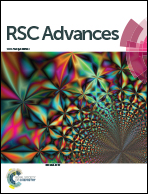Tweaking of the supramolecular gelation properties of a dipeptide based ambidextrous organogelator through the cooperative influence of hydrophobicity, steric bulk and conformational flexibility of the side chain residue of a single hydrophobic α-amino acid encrypted on a designed molecular frame†
Abstract
The cooperative influence of the side chain hydrophobicity, steric volume and conformational flexibility of a single hydrophobic α-amino acid (αAA) has been found to be pivotal in the tuning of the gelation properties of a dipeptide based ambidextrous organogelator, N-n-hexadecanoyl-αAA-(β)Ala-OBn [αAA = L-isomers of Ala (4a), Val (4b), Leu (4c), Ile (4d), Phe (4e) and Gly (4f)]. An optimal balance among all the above parameters becomes apparently ideal for 4b ≥ 4d > 4a > 4c, whereas, between 4c and 4d with isomeric side chains, 4c shows much weaker gelation. Moreover, 4e gets the extra stability due to its side chain π–π type attractive interaction with an apparent pseudocentro-symmetric H-bonded amide network. The aromatic unit at the C-termini apparently helps a parallel β-sheet type alignment of gelators with an interdigitated N-acyl unit. Gelation ability has also been affected by the conformational flexibility of the side chains, while the Tgel value decreases with the increase in hydrophobicity of the media. The increase in hydrophobic bulk of the αAA-side chain of the gelator increases the Tgel values in polar aprotic solvents. WAXRD studies reveal a Pm3m type cubic lattice being omnipresent in their xerogels without much alteration of the interdigitated molecular arrangement, even on such structural modification; however, d100 values decrease on going from apolar to aprotic polar media, whereas, it increases on going from aprotic polar to protic polar solvents (except 4c). Therefore, a substantial hydrophobic influence is presumably operative in aprotic polar media, but a competitive H-bonding interaction from polar protic solvent reduces the compactness of the network. A comparable influence of hydrophobicity is found for 4c and 4d in the xerogel state. Gelation from the achiral variety (4f), though weak, emphasizes that proper alignment of supramolecularly interactive moieties and solvophobic association play primary roles towards gelation, which is reinforced by chirality. The solvent effect on such systems was further analyzed using various solvent parameters and found to have an important role in such a self-assembly process.


 Please wait while we load your content...
Please wait while we load your content...